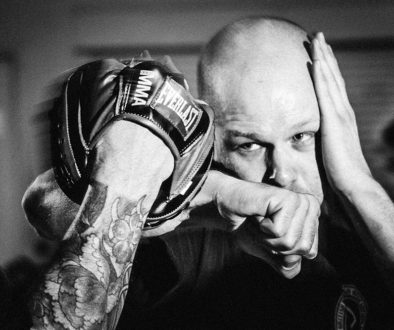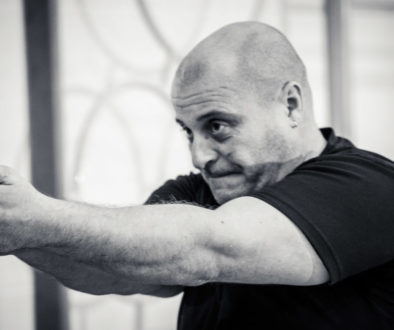Krav Maga Bristol: Multiple attackers
Krav Maga Bristol: Multiple Attackers
Krav Maga Bristol Instructor Jim Halton writes on the realities about defencing against mutiple attackers.
“When facing multiple opponents you must attack first and keep attacking until the danger subdues.” – Miyomoto Musashi
Avoidance, escape, dissuasion, attack.
 Your only chance of survival in these scenarios is either to run away if possible, or attack first and hit everything that moves. To survive a multiple opponent attack we must be brutally honest and inform the student of the high skill factor and sheer bravado needed when attempting such a feat. The only truly safe cure is prevention.
Your only chance of survival in these scenarios is either to run away if possible, or attack first and hit everything that moves. To survive a multiple opponent attack we must be brutally honest and inform the student of the high skill factor and sheer bravado needed when attempting such a feat. The only truly safe cure is prevention.
Krav Maga Bristol Instructor Jim Halton writes:
Your Krav Maga should be pre-emptive and attack first, but that is not much use if your attacking tools are not up to scratch. If you are going to be first your attacking movement needs to be ferocious, not just enough to stun the guy that you hit but also to frighten the shit out of his partners in crime. If you do not sufficiently put the fear of God into them then the chances are you are still likely to lose. An effective physical response is not always about being fast, strong, accurate, trained or even brave, though they are all, of course, important factors. First and Foremost it’s about being cunning, ferocious and, above all else, ‘first’. This is especially so when dealing with two, three or more attackers. If you’re not first, you will most likely be last. As we all know, ‘last is lost’ in the pavement arena.
“I have been involved in over a hundred fights where the numbers were against me; I won because I was first to initiate the physical attack.” – Geoff Thompson
Most assaults are preceded by verbal entrapments. These may be short to blunt or long too prolonged. Former or latter, it is present and you must — if all other options have been exhausted — act by attacking as soon as you are sure an attack upon your person is imminent. With the lone assailant you may prolong the verbal and control range using a passed two simple fence whilst concentrating upon him and your attack/escape. With multiple attackers this is not so easy. While it is possible to control the range of one assailant it can be very difficult to control the range of several at once, so time is of the essence.
The longer you take to analyse the situation and prepare, the less chance when grabbed you will have of effecting a pre-emptive attack because the attackers will gradually be surrounding you and getting closer in order to make their assault a little easier.
When they do attack, it will not be one at a time like in the films, but all at once and with brutal ferocity, leaving you very little chance of fighting back. Dispatching the concept of blocking an attack rarely works, especially with multiple attackers.
Beware! For every 2-3 seconds (variable) that you delay your first pre-emptive strike you will be fighting one more opponent. If you manage the pivotal seconds effectively, your first attack will be to the opponent in front, then to the next closest/most dangerous opponent.
If you feel an attack on you is imminent pre-empt it by attacking them first. This is the absolute pivotal factor in such a scenario: attack first.
Attack is your best means of defence. After your pre-emptive strike, it is best to make your escape, if possible. If not, hit everything that moves and shout loudly to underline your resolve, to psyche out your antagonists and to attract attention to your assault.
As with every scenario that begins with dialogue, use the four ‘D’s; only make a pre-emptive attack if no other option is open to you. If the attackers have not heeded your warnings to back off and are still forward moving, then use your lead hand fence to keep a safe distance. Be submissive, engage the opponent’s brain using your action trigger, and attack.
There seems to be a big ego problem with confrontation, especially with men and especially when they are with their women. They feel that to avoid is to bottle out. Not so. Even Sun Tzu, a great warrior general some twenty-five centuries ago, advised flight when the numbers were stacked against you. Ego does not or should not come into it: you are not defending your ego, you are defending your life. So if you can run then run for your life. There will be another day, another arena where the odds will not be so great. Remember the sequence: avoidance, escape, dissuasion, attack.
The Four ‘D’s
There are four techniques often used by attackers, especially muggers and rapists, in preparing victims for attack. Although these are nearly always overlooked by self-defence writers, the four ‘D’s – dialogue, deception, distraction and destruction – are the most important element of self-protection to be aware of.
DIALOGUE
Dialogue designed to disarm and distract the targeted victim is the professional attacker’s most common priming technique. An attacker will approach a potential victim in a non-threatening way and begin a conversation. Often, he will ask a question about directions, ask if you have the time, a light, or any spare change. His objective is to make you think about his question, so that you do not notice the weapon he is drawing or his accomplice coming round behind you. It only takes a second of distraction for you to get into deep trouble. Understanding this will make you more aware and keep you alert, which is the most important part of target hardening.
DECEPTION
An attacker uses deception to make himself appear harmless. Dialogue and appearance are the most common methods used to deceive victims, to make them let down their guard. Do not expect dangerous people to stand out in a crowd.
Attacks may start with politeness, even with an ingratiating approach. Deception is the attacker’s greatest asset. Every attack I have ever documented that was not a blind-side attack (the ones that happen when you do not use awareness) came through deception, the attacker using this as a window of opportunity.
DISTRACTION
Distraction is a part of deception and usually comes through dialogue. The attacker may ask his victim a question and then initiate attack while the victim is thinking about the answer. This distraction also switches off any instinctive, spontaneous physical response the victim may have. A man with twenty years of physical training in a fighting art can be stripped of his ability by this simple ploy. I have witnessed many trained fighters, who are monsters in the controlled arena, get beaten by a guy with only an ounce of their physical ability. How? They were distracted before the attack. Rob, a hardened street fighter and nightclub doorman, always told potential opponents that he didn’t want to fight before he attacked them. Their first thought when recovering consciousness would be: ‘I’m sure he said he didn’t want to fight!’
If the distraction is submissive, ‘I don’t want any trouble, can we talk about it?’ it will also take your assailant down from a state of fight or flight to one of low awareness, because your submissiveness tells him that the danger is over and he can relax into self-congratulation.
Brain engagement, via disarming/distracting dialogue, gives the victim a blind second. This is when the assailant strikes. The distraction is also used by the experienced attacker to take down any protective fences that may have been constructed by the victim (the ‘fence’ is dealt with in detail in a later chapter).
DESTRUCTION
This is the final product of expert priming. Few people survive the first physical blow and most are out of the game before they even realise that they are in it. Even trained martial artists often get suckered by the four ‘D’s because these do not appear on their training curriculum. They do not understand the enemy they are facing. The attacker uses the techniques of deception and distraction to prime a victim that is only trained in ‘physical response’.


